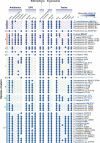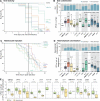Relation of pest insect-killing and soilborne pathogen-inhibition abilities to species diversification in environmental Pseudomonas protegens
- PMID: 37311938
- PMCID: PMC10432460
- DOI: 10.1038/s41396-023-01451-8
Relation of pest insect-killing and soilborne pathogen-inhibition abilities to species diversification in environmental Pseudomonas protegens
Abstract
Strains belonging to the Pseudomonas protegens phylogenomic subgroup have long been known for their beneficial association with plant roots, notably antagonising soilborne phytopathogens. Interestingly, they can also infect and kill pest insects, emphasising their interest as biocontrol agents. In the present study, we used all available Pseudomonas genomes to reassess the phylogeny of this subgroup. Clustering analysis revealed the presence of 12 distinct species, many of which were previously unknown. The differences between these species also extend to the phenotypic level. Most of the species were able to antagonise two soilborne phytopathogens, Fusarium graminearum and Pythium ultimum, and to kill the plant pest insect Pieris brassicae in feeding and systemic infection assays. However, four strains failed to do so, likely as a consequence of adaptation to particular niches. The absence of the insecticidal Fit toxin explained the non-pathogenic behaviour of the four strains towards Pieris brassicae. Further analyses of the Fit toxin genomic island evidence that the loss of this toxin is related to non-insecticidal niche specialisation. This work expands the knowledge on the growing Pseudomonas protegens subgroup and suggests that loss of phytopathogen inhibition and pest insect killing abilities in some of these bacteria may be linked to species diversification processes involving adaptation to particular niches. Our work sheds light on the important ecological consequences of gain and loss dynamics for functions involved in pathogenic host interactions of environmental bacteria.
© 2023. The Author(s).
Conflict of interest statement
The authors declare no competing interests.
Figures







Similar articles
-
Phylogenetically closely related pseudomonads isolated from arthropods exhibit differential insect-killing abilities and genetic variations in insecticidal factors.Environ Microbiol. 2021 Sep;23(9):5378-5394. doi: 10.1111/1462-2920.15623. Epub 2021 Jun 30. Environ Microbiol. 2021. PMID: 34190383 Free PMC article.
-
T6SS contributes to gut microbiome invasion and killing of an herbivorous pest insect by plant-beneficial Pseudomonas protegens.ISME J. 2019 May;13(5):1318-1329. doi: 10.1038/s41396-019-0353-8. Epub 2019 Jan 25. ISME J. 2019. PMID: 30683920 Free PMC article.
-
Transcriptome plasticity underlying plant root colonization and insect invasion by Pseudomonas protegens.ISME J. 2020 Nov;14(11):2766-2782. doi: 10.1038/s41396-020-0729-9. Epub 2020 Sep 2. ISME J. 2020. PMID: 32879461 Free PMC article.
-
Insect pathogens as biological control agents: Back to the future.J Invertebr Pathol. 2015 Nov;132:1-41. doi: 10.1016/j.jip.2015.07.009. Epub 2015 Jul 27. J Invertebr Pathol. 2015. PMID: 26225455 Review.
-
Multifaceted interactions between the pseudomonads and insects: mechanisms and prospects.Arch Microbiol. 2021 Jul;203(5):1891-1915. doi: 10.1007/s00203-021-02230-9. Epub 2021 Feb 26. Arch Microbiol. 2021. PMID: 33634321 Review.
Cited by
-
Pyoluteorin regulates the biosynthesis of 2,4-DAPG through the TetR family transcription factor PhlH in Pseudomonas protegens Pf-5.Appl Environ Microbiol. 2024 Apr 17;90(4):e0174323. doi: 10.1128/aem.01743-23. Epub 2024 Mar 12. Appl Environ Microbiol. 2024. PMID: 38470180 Free PMC article.
-
Expanding the Pseudomonas diversity of the wheat rhizosphere: four novel species antagonizing fungal phytopathogens and with plant-beneficial properties.Front Microbiol. 2024 Jul 15;15:1440341. doi: 10.3389/fmicb.2024.1440341. eCollection 2024. Front Microbiol. 2024. PMID: 39077740 Free PMC article.
-
The genome of a steinernematid-associated Pseudomonas piscis bacterium encodes the biosynthesis of insect toxins.Access Microbiol. 2023 Oct 5;5(10):000659.v3. doi: 10.1099/acmi.0.000659.v3. eCollection 2023. Access Microbiol. 2023. PMID: 37970093 Free PMC article.
-
Natural plant disease suppressiveness in soils extends to insect pest control.Microbiome. 2024 Jul 16;12(1):127. doi: 10.1186/s40168-024-01841-w. Microbiome. 2024. PMID: 39014485 Free PMC article.
-
The repressor PrtR1 and the global H-NS-like regulators MvaT and MvaV enable the fine-tuning of R-tailocin expression in Pseudomonas protegens.BMC Microbiol. 2025 May 11;25(1):286. doi: 10.1186/s12866-025-03983-9. BMC Microbiol. 2025. PMID: 40350448 Free PMC article.
References
Publication types
MeSH terms
Supplementary concepts
LinkOut - more resources
Full Text Sources
Molecular Biology Databases

